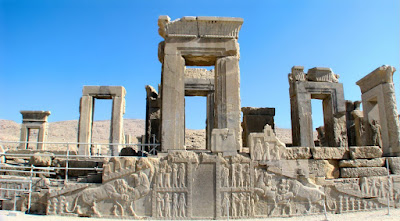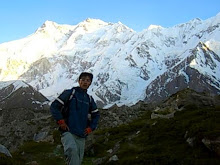Iran - Shiraz and Persepolis
Day 3...15th Nov 2010...
Travel Expenses
*** Total: 250,000 IRR per person ***
Admission to Arg of Karim Khan: 5,000 IRR each
Admission to Vakil Mosque: 5,000 IRR each
Admission to Nasir al-Mulk Mosque: 15,000 IRR each
Admission to Tomb of Hafez: 5,000 IRR each
Accomodation @ Anvari Hotel: 280,000 IRR (excluding breakfast)
Food and Miscellaneous: 80,000 IRR each
Arg of Karim Khan
Fortress of Arg of Karim Khan


Interesting picture of Karim Khan himself above the fort's entrance

Large open courtyard filled with citrus trees inside the fort

Beautiful stained glasses

Scene of Karim Khan welcoming his visitors

Traditional bathrooms beneath the courtyard


Love the symmetry!

Vakil Mosque and Bazaar
Northern and southern iwans of Vakil Mosque


Ceiling of the iwans are decorated with colorful tiles

Vaulted prayer hall


Neatly carved columns

Always looking for symmetry! =)

Shop outside Vakil Mosque

Lots of shops in Vakil Bazaar selling beautiful Persian carpets

And many varieties of spices


Nasir al-Mulk Mosque
Entrance of Nasir al-Mulk Mosque

Courtyard views of the mosque


Northern iwan

With fine stalactite moulding

Stunning stained glasses from inside the prayer hall


Colorful lightings on the floor

Painting of Ruhollah Khomeini

And Ali Khamenei

Ambient settings in one of the rooms

Tomb of Hafez
The Tomb of Hafez and its associated memorial hall, the Hāfezieh, are two memorial structures in memory of the celebrated Persian poet Hafez, who was born in Shiraz and is one of the most famous Gnostics and poets of Iran. Many people still come to pay homage to this master of poetry. The mausoleum itself is located in a lovely garden, and has an atmosphere of peace and calm that is quite unique.
Beautiful garden near the entrance

Octagonal pavilion of Hāfezieh where Hafez's tomb lies


Lots of locals coming to pay their respect in the evening


Hāfezieh with its ambient night lighting


Stayed in Anvari Hotel for the first night, but shifted to Sasan Hotel (more preferred) next door for the second night

Double room in Anvari Hotel with attached shower

Day 4...16th Nov 2010...
Travel Expenses
*** Total: 510,000 IRR per person ***
Day Tour to Persepolis and Naqsh-e Rustam: 170,000 IRR each
Accomodation @ Sasan Hotel: 360,000 IRR
Food and Miscellaneous: 160,000 IRR each
Persepolis
Persepolis was the capital of the Persian Empire under the Achaemenid Empire around 2500 years ago. To the ancient Persians, the city was known as Pārsa, which means "The City of Persians". Built by Cyrus the Great and Darius the Great, it was eventually destroyed by Alexander the Great when he stormed through the Persian Empire.
Took a day tour from Pars Tourist Agency to Persepolis

Small kid selling coconut sweets

Views of Persepolis from afar

Royal palaces

Walking towards the Grand Stairway

Xerxes' Gateway aka Gate of All Nations

Up the Grand Stairway

Each step was shallow so that Persians could walk up gracefully in their long elegant robes

Gate of All Nations up close

Lamassu (winged bull with Persian head) guarding the gateway



Cuneiform inscription in Old Persian, Neo-Babylonian and Elamite language

Columns that were used to support the grand hall of the Gate of All Nations



Another pair of Lamassus which are in better conditions




Impressive Gate of All Nations from far

Fearsome creatures that used to adorn the top of the columns


Broken segment of a column

Unfinished Gate to the Palace of 100 Columns

Pair of bulls that used to adorn the top of the columns

While some were used to guard the entrance into different halls

Ruins of the Palace of 100 Columns

Relief of Ahura Mazda can be commonly seem as Zoroastrianism was the state religion

Another relief showing the King on the throne

The King vs the Evil Creature

Soldiers of the different subject nations

Looking up towards the Tomb of Artaxerxes II

Reliefs of Persian Soldiers near the Apadana Staircase

Impressive reliefs at the Apadana Staircase

Showing arrival of delegates of different subject nations to meet the King

Each group of delegates brought along different types of tributes




Intricate floral design

Persian and Median soldiers


Zoroastrian symbol for Nowruz, signifying a new year (spring equinox) when the powers of the fighting bull (personifying the Earth) and the lion (personifying the Sun) are equal

Another inscription that annouced that the Apadana Palace was started by Darius the Great

Remaining tall columns of the Apadana Palace, the greatest palace of Persepolis



The Winter Palace

With its reliefs and inscription

Another relief of Ahura Mazda above the entrance to Xerses' Hall of Audience (Tripylon)

A beautiful bull head in front of the museum

Remainings of the Treasury which was plundered by Alexander the Great

A huge stone with reliefs showing the King with his delegates and soldiers

Tomb of Artaxerxes II on the hill above the Treasury


Reliefs showing the King reaching to his God Ahura Mazda in his afterlife

Definitely worthwhile to climb to the hilltop to have a panoramic view of the enormous scale of Persepolis!
~ View Picture Enlarged ~

Naqsh-e Rustam
Naqsh-e Rustam is an archaeological site where four tombs belonging to the Achaemenid kings are carved out of the rock face. The tombs are known locally as the 'Persian Crosses', after the shape of the facades of the tombs. From left to right, the tombs are believed to be of Darius II (423-404 BC), Artaxerxes I (465-424 BC), Darius I the Great (522-486 BC) and Xerxes I (486-465 BC) respectively.
Panoramic view of the "4 Persian Crosses"
~ View Picture Enlarged ~

Tomb of Darius the Great

Reliefs showing the King reaching to his God Ahura Mazda in his afterlife

Most famous of the Sassanid rock reliefs which depicts victory over the Roman emperors

Ka'ba-ye Zartosht, meaning the "Cube of Zoroaster"

Ka'ba-ye Zartosht against the backdrop of Naqsh-e Rustam

Dinner at Sharzeh Traditional Restaurant, perfect Iranian atmosphere with music, singing and dancing!


Interesting barley soup

Double room in Sasan Hotel, with attached toilet and shower








No comments:
Post a Comment